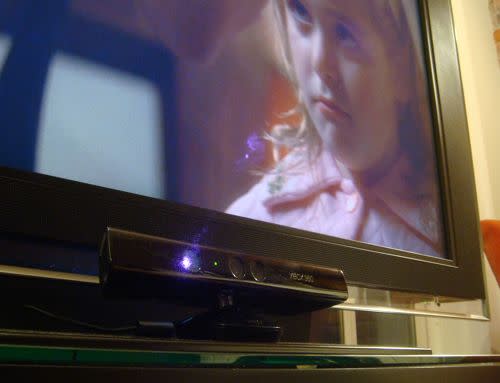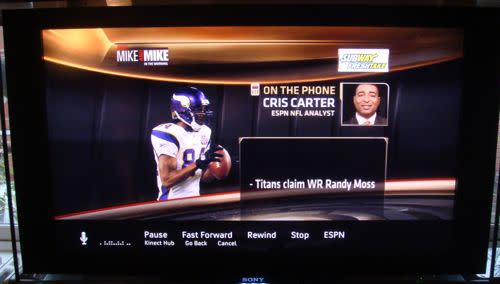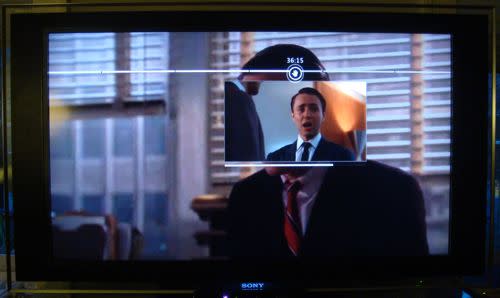 Today in Tech
Today in TechUsing Kinect to watch movies, play tunes on the Xbox 360
Plenty of digital ink has already been spilled about how Microsoft's impressive new motion-sensing camera performs as a game controller — or as a controller without the controller, as it were — but what about when it comes to using your hands and voice to queue up your favorite tunes, or find a specific scene in a movie? Read on.
I have to say, it's the Kinect's "Minority Report"-style capabilities that captured my imagination the most during Microsoft's various demos over the past year or so, which have shown users waving their hands in the air to scan to a specific scene in a movie, or saying commands like "Xbox, Pause" to freeze the image.
The tiled Xbox Dashboard seems like it would be perfect for swiping up and down, or back and forth with a simple wave, and indeed — as soon as I'd plugged my new Kinect into the back of my Xbox 360 console and went through the brief, relatively painless calibration process, I started waving my hand in the hopes of manipulating the Dashboard tiles, just like Tom Cruise did with that ultra-cool computer console in the movie.
Alas ... that's not exactly how Kinect works, although Microsoft is clearly onto something here. When you're at the main Xbox Dashboard screen with Kinect plugged in, you still must use the analog sticks on the Xbox controller to switch from one standard Dashboard tile to another. Oh well.
In the bottom-right corner of the screen, though, you'll see a ghostly black-and-white video image of your living room in a small frame, right next to a microphone icon. Wave your hand, and you'll see your little ghostly image wave back at you, until a hand-shaped icon appears below a curved, pulsing line with arrows on both ends. Wave a little more, in big enough arcs, and you'll slide over to what's called the "Kinect Hub" — a Kinect-friendly interface for controlling some, but not all, of the Xbox 360's media features.
Don't want to wave? You can always just talk. Say "Xbox," and a little menu appears at the bottom of the screen with available voice commands, such as "Kinect," which takes you to the Hub.
What is the Kinect Hub, exactly? It's a series of panels — eight per screen — that you can select by either waving your hand (you move the floating hand icon over the panel you want, then hold it until a circle appears) or using a voice command (like "Xbox, ESPN").
For now, unfortunately, the selection of panels is somewhat limited. On the first page, you can fire up the game disc in your optical drive, watch a trailer for a featured game or movie, start a live video chat with a friend (which I haven't tried yet) or launch the ESPN, Last.fm, or Zune apps. Sorry, folks: no Kinect-controllable Netflix, Facebook, or Twitter, at least not yet.
Still, I had fun with the Kinect-ready Xbox features that were under my control. Launch the Zune app, for example, and say "Xbox, Suggest a movie" to start watching previews of new rentals; if you like what you see, you say "Xbox, Watch this" to start watching, or "Xbox, Next" for another preview. Or you can jump into your library of TV episode purchases, waving your hand to select the series and episode you want to watch.
Even better is scanning within a video for a certain scene. You wave your hand, move the floating hand icon over the little white mitt on the progress bar, and then swipe back and forth to scan the video forward and backward. I have to say, I was surprised by the degree of control I had; I was afraid the video would fly all over the place, but Kinect did a great job of tracking even my most subtle movements, allowing me to move forward or back in steps as small as 15 seconds.
Of course, you can also scan forward or back using your voice; just say "Xbox, Fast Forward," "Xbox, Rewind," or ... well, you get the picture.
Searching for movies or music with Kinect is a little more involved, as you can imagine. Once you select the Search icon, you wave and swipe up to pick your first letter; you can then pick from a list of search results (categorized by movies, TV, music videos, or artists), or you can keep spelling out a search term with more waving. After a little of this, I stopped waving my (increasingly tired) hand and started groping around for my Xbox controller.
Once you finally have a song queued up, you can being playback by saying "Xbox, Play," or skip to the next track by waving and "pressing" the left arrow (or just say "Xbox, Next"). You can't mark a song as a favorite with Kinect, though, and I should also note that Kinect occasionally had trouble hearing my commands when the music was blaring. (Raising my voice a bit usually did the trick.)
Will using Kinect to watch videos or listen to music on the Xbox be easier than fumbling around in the dark for the Xbox controller? Or will pressing a button prove to be easier than waving a hand?
I'll have to use Kinect a bit more before I can say for sure; right now, I'm still trying to wrap my brain around what it means to talk and wave to control a video rather than pushing a stick. It's a heady experience, I'll grant you that, although it's frustrating when Kinect doesn't see your waving hand (hey, I'm right here!) or listen to your voice ("Xbox ... Xbox!") when it should.
For the most part, though, there was something a little bit thrilling about using gestures rather than remotes or controllers — and remember, it doesn't have to be an either/or situation; it's not like you have to trade in the Xbox controller for a Kinect camera.
So yes, it's cool ... but $150 worth of cool? I'll have more on that later, especially once I crack open some Kinect games (I have Kinect Sports and Kinect Adventures here at home). I should also point out that the Kinect I have in my living room isn't a review unit; I went ahead and paid for the thing, so I'm sure I'll soon have definite feelings about whether I got my money's worth.
Got any questions about Kinect? Post 'em below and I'll do my best to get back to you.
— Ben Patterson is a technology writer for Yahoo! News.




